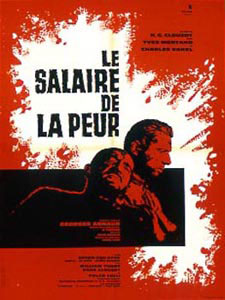 |
| Laurent Terzieff in La Prisonnière |
Cast: Laurent Terzieff, Elisabeth Wiener, Bernard Fresson, Dany Carrel, Dario Moreno, Claude Piéplu, Noëlle Adam, Michel Etcheverry. Screenplay: Henri-Georges Clouzot, Monique Lange, Marcel Moussy. Cinematography: Andréas Winding. Production design: Jacques Saulnier. Film editing: Noëlle Balenci.
La Prisonnière (aka Woman in Chains) was Henri-Georges Clouzot's last film, but in many ways it feels more dated the ones he made a decade earlier, the classic The Wages of Fear (1953) and Diabolique (1955). It's about a couple, Josée (Elisabeth Wiener) and Gilbert (Bernard Fresson) in an "open" relationship that actually seems to be open only on his side. He's an artist, working with visual effects and geometric sculpture, preparing for an exhibition of op art and kinetic art in a gallery owned by Stanislas Hassler (Laurent Terzieff). His preparation includes sleeping with a prominent woman art critic, which Josée tolerates grudgingly. Meanwhile, she becomes involved with Stanislas, which stirs Gilbert's jealousy. She visits Stanislas in his apartment over his gallery, where he puts on a slide show of some of the works in his collection, one of which is a photograph of a nude woman in chains. Josée's curiosity is aroused, in part because she's a film editor working on a documentary about abused women. The photographer is Stanislas himself, and she lets herself be persuaded to watch him photograph one of his models. Josée reacts with a mixture of revulsion and desire. Unfortunately Wiener is not up to the demands of the role: As she tries to portray a woman breaking free from conventional morality, she looks dithery and awkward. Stanislaus taunts Josée that she's a bourgeoise (which the subtitle inadequately translates as "housewife"), and his bullying begins to break down her resistance: She becomes an active participant in his shoots and falls completely in love with him, with disastrous results. One problem with the film is that the depiction of Stanislas's sadomasochism feels timid: We've seen much more disturbing images than these, of topless women in mildly tortured poses, "glamour porn" at worst. (Luis Buñuel gave us more convincing perversity a year earlier in Belle de Jour.) Clouzot seems to be trying to make both a fable about repression and liberation and a cutting satire of the art world of the 1960s, but he fails to make the two aims coalesce.



